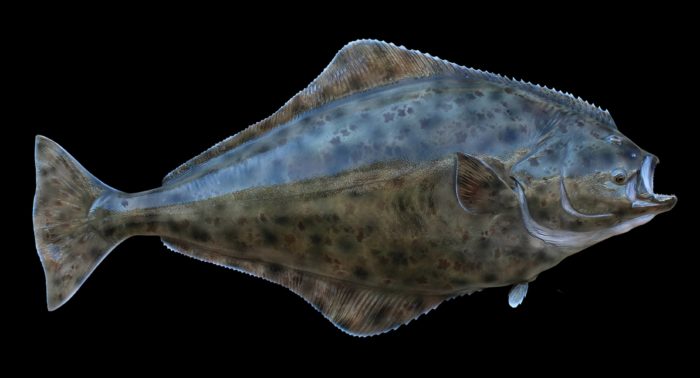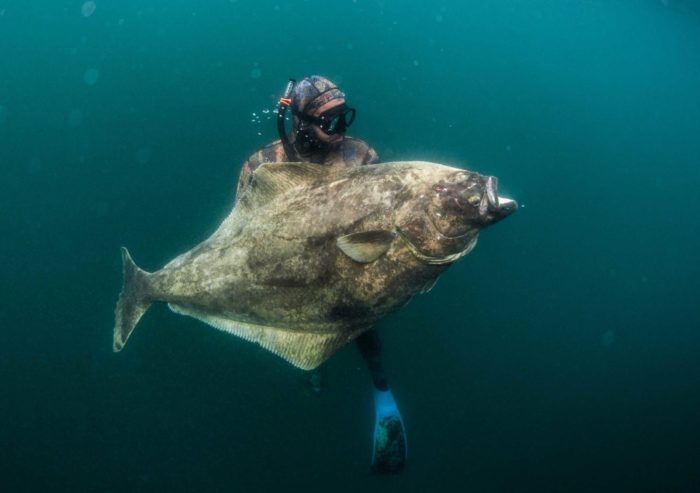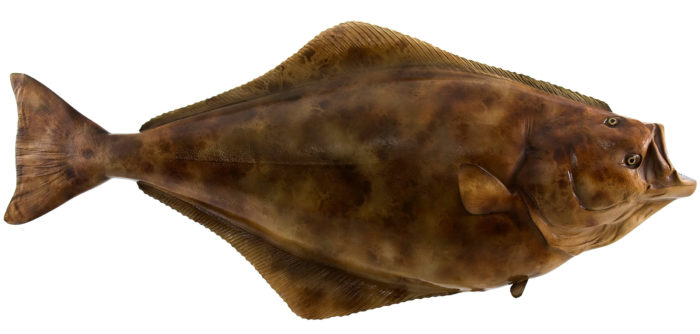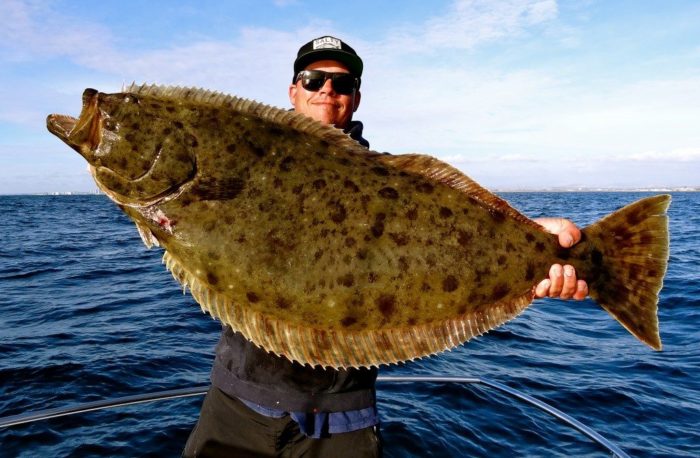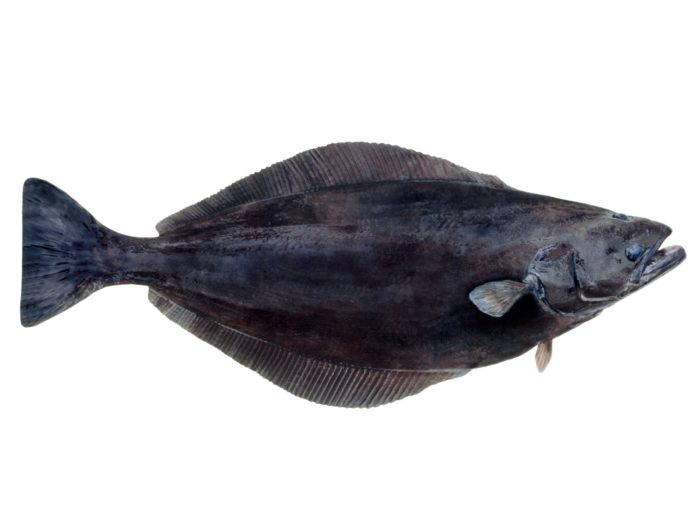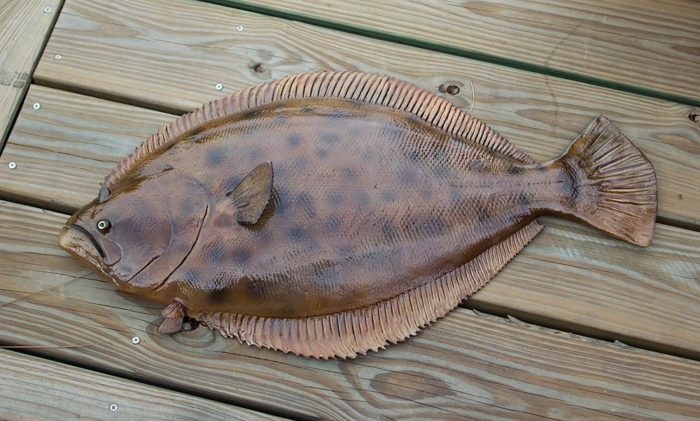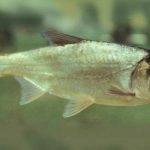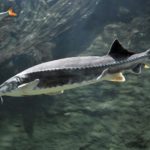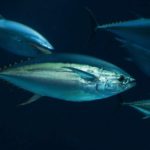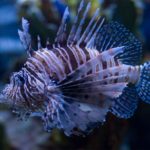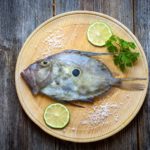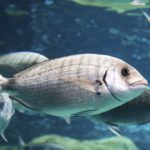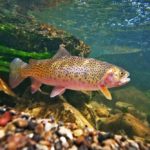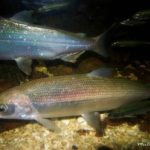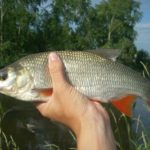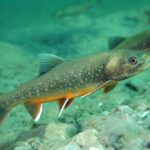Halibut is one of the most popular fish in the world, found in the Atlantic and Pacific oceans. It is distinguished by tender meat, rich in protein, healthy fatty acids, vitamins and minerals. In culinary traditions around the world, halibut is used in a variety of dishes, be it fried fish, soups, pies or salads. But in addition to its taste, it is also considered an object of scientific research, including in the field of breeding and aquaculture.
Description of the fish
Halibut is the common name given to five species of fish that are classified as members of the Flounder family. They are found in cold Atlantic waters. These large aquatic creatures are highly sought after by commercial fisheries, and their distinctive appearance and behavior make them an important element of the aquatic ecosystem.
Halibut, which are similar to flounder, usually remain motionless on the ocean floor with only their eyes visible above the sand or mud. They are able to rotate their eyes in turn, and when tracking down prey, they freeze until something gets too close, and then quickly rush at the victim.
These flatfish are vulnerable to large predators such as whales, but the most significant threat is from humans.
Appearance
Halibuts, which the English call halibuts, have a flattened shape and move sideways, with one side pointing down and the other pointing up. The upper parts of the fish are typically grey, brown or black in color and are usually dotted with spots and dots that help it blend in with the sandy or muddy ocean floor. Meanwhile, the underside of the fish is usually white. The coloring of these fish does not depend on the waters in which they are found.
In halibut, both eyes are usually located on the upper, dark side of the body. The dorsal fin extends from the eyes to the end of the tail, and its mouth is located at or above the middle of one eye and is almost symmetrical in shape. Its scales are very small and are embedded in the skin, making the fish smooth to the touch. The tail of the fish is wide, symmetrical, practically without a fork. The lateral line is strongly curved.
Left-eyed halibuts are very rare; this trait occurs in only 1 in twenty thousand individuals. The eyes are located on the left side of the fish's body.In this case, the part is pigmented with a dark color, while the right side is pale, almost white. When swimming, their pale side faces down.
Atlantic halibut can reach two meters in length and weigh up to two hundred and fifty kilograms, while the Pacific species is much smaller - not exceeding a weight of 200-215 kilograms. Females of this species tend to develop faster and become larger than males, which rarely reach more than a hundred centimeters in length.
Interesting! In 2014, a German fisherman hooked an incredible fish - a record-breaking Atlantic halibut that was too big to fit on the boat. He weighed two hundred and forty kilograms, surpassing the previous record of two hundred and fifteen kilograms. The largest Pacific halibut was caught off the coast of Alaska and weighed two hundred and eight kilograms.
Habitat
The Atlantic variety is found in northern Atlantic waters, and the Pacific variety is found in northern Pacific waters. They tend to live on various types of seabed and are able to move through the water column to search for food. Their habitat ranges from depths of 5 meters to three hundred meters, but they have also been observed at depths reaching a kilometer.
Fish nutrition
During the first year of life, halibuts consume plankton. As they mature, young halibut (one to three years old) feed on shrimp, crustaceans and tiny fish. Larger halibuts feed on herring, pollock and perch, as well as various shellfish and other marine life. Octopuses also look attractive to halibut, although they can be difficult to catch.
Reproduction
Males of the flounder family usually become ready to spawn at eight years of age, while most females reach sexual maturity by twelve years of age. Halibut spawning usually occurs from November to March at a depth of six meters to half a kilometer.
Depending on their length and weight, females produce tens of thousands to a couple of million eggs. After about two weeks, the eggs hatch and the fry are carried along the ocean currents until they reach shallow coastal waters where they find a breeding ground.
Halibut fry initially have eyes on each side of the head, but over time, when they reach a length of about three centimeters, one eye “moves” to the right side, while the left one becomes pale in color. By the age of six months, young fish usually settle to the bottom in coastal shallow waters.
Varieties
There are five types of halibut:
- Atlantic Whitebark. Species listed in the Red Book due to low population size. It is found on rocky, sandy or muddy ocean floors at depths of fifty meters to two kilometers. It is one of the largest bony fish in the world and is known to migrate long distances.
- Pacific. Considered to be the second largest of its kind, this fish is easily found in northern Pacific waters. The population of this species is closely monitored and is not endangered.
- Asiatic. The maximum size reaches one meter. This fish is not considered an endangered species and remains a commercial fishery. This bottom-dwelling fish does not move long distances; can weigh from one to three kilograms. Its diet mainly consists of pollock.Unfortunately, this species sometimes contains parasites that cause the meat to become mushy when cooked, reducing its nutritional value and appetizing appearance.
- American. Spawning for this species occurs between December and February. Its lifespan is up to twenty-seven years, and its length can reach 70-90 cm.
- Greenland or bluebark. This is a predatory fish that lives at a depth of five hundred meters to one kilometer. She prefers low temperatures. It is distinguished by the absence of migration of the left eye, which remains on the spinal ridge and does not shift to the right side.
Who do halibuts get confused with?
Halibut is sometimes confused with dory and flounder, but these fish can be distinguished by some characteristic features:
- Dory. This fish is not a flounder, despite its similar appearance. The dory's eyes are on opposite sides of its head, and it swims vertically, like all other fish. Moreover, the diet of this fish is almost the same as that of halibut.
- Flounder. Halibuts typically have forked tails with pointed ends, while flounder have rounded tails. The eyes of a flounder can be located on any side of the body. So, if you see a fish in the store that has its eyes on the left side, it is most likely a flounder rather than a halibut, which usually looks to the right.
Beneficial features
The chemical composition of halibut varies slightly depending on where it is caught and where it feeds. However, in general, 100 grams of fillet contains:
- Proteins – 18 grams.
- Fats – 2 grams.
- Carbohydrates – 0 grams.
- Calories – about 90 kcal.
- Water – about 79 grams.
Halibut fillets are also a source of important nutrients such as vitamins B12, D, E, as well as minerals including selenium, iodine, phosphorus and magnesium.
Omega-3 fatty acids found in halibut have beneficial effects on the cardiovascular system, such as reducing the risk of blood clots in the arteries that lead to heart attacks.
Halibut is a good source of vitamin B12, vitamin B6 and folic acid, which help reduce levels of a non-proteinogenic amino acid, a substance that can damage artery walls. It is also a very good source of magnesium, which works as a natural calcium channel blocker, increasing blood flow.
Eating halibut improves the conduction properties of heart cells and helps protect against fatal cardiac arrhythmias while lowering blood pressure. It can also prevent arthritis and promote healthy brain function.
In addition, eating fatty fish has been shown to effectively reduce the risk of developing the most dangerous form of kidney cancer.
It provides significant protection against both early and late age-related macular deterioration and prevents the development of dry eye syndrome. In addition, the selenium it contains is a major antioxidant, which is very important for liver health. It also protects against ovarian and digestive tract cancers.
Why is it dangerous?
Pregnant women and those who are of childbearing age and trying to become pregnant should avoid eating too much halibut or other seafood, as they are sometimes contaminated with mercury.
People with existing kidney problems or gout should minimize their consumption of halibut meat due to its purine content, which breaks down into acid and can potentially lead to the formation of kidney stones.
Additionally, it is wise to adjust the amount of fatty foods consumed depending on how a person feels after first trying them. After all, allergic reactions can occur from any food.
Finally, it is important to note that these fish should not serve as the main source of protein in the diet.
Application
Halibut fish is widely used in cooking, both at home and in restaurants. It is valued for its delicate taste and soft texture of meat.
This aquatic inhabitant is also used in the production of canned food - fish sticks, cutlets, etc.
Additionally, halibut is a popular sport fish, especially in North America and Europe. It is also considered an important commercial fishing site.
Cosmetology
Cosmetic companies know about the positive effects of halibut. Studies have shown that due to its Omega-3 fatty acid content, the oil from this fish has restorative properties, helping to heal minor cuts and abrasions, as well as providing a smooth surface to the skin.
Creams made from this ingredient are useful for protecting against irritation and allergies, reducing wrinkles, giving skin elasticity, treating chronic dermatitis and fighting acne.
Halibut Recipes
Halibut is prepared in various ways: fried, baked, boiled, stewed.
The healthiest cooking method is considered to be baking in the oven or on the grill.At the same time, the fish retains its beneficial properties and does not lose vitamins and minerals, and the dish is not additionally “loaded” with fat, since a minimum amount of oil is usually used for cooking. In addition, baking in the oven or on the grill allows you to preserve the pleasant taste and aroma of the fish.
It is also recommended to steam or simmer halibut in its own juices to retain maximum nutrients. When frying fish, you should use natural oils, such as olive or coconut, to avoid the formation of carcinogens during the processing of fish at high temperatures.
Halibut stewed with tomatoes and couscous
Braised halibut with couscous, tomatoes and olive oil is a great dinner dish that's easy to make at home.
Ingredients:
- 4 halibut pieces (about 150 g each).
- 1 large onion, cut into rings.
- 2 cloves garlic, minced.
- 4 tomatoes, diced.
- 1 cup couscous.
- 1/2 cup boiling water.
- 1/4 cup olive oil.
- Salt and freshly ground black pepper to taste.
- Lemon juice and fresh parsley for serving.
Recipe:
- In a large skillet, heat olive oil over medium heat. Add the onion and garlic and cook, stirring, until the onion is soft and translucent, about 5 minutes.
- Add the tomatoes to the pan and cook, stirring, for another 5 minutes until softened.
- Add a piece of halibut to the pan, add salt and pepper to taste, and cook for 5 minutes on each side until the fish is golden brown.
- Meanwhile, in a large bowl, pour boiling water over the couscous, add a pinch of salt, stir and cover. Let sit for 10 minutes until the couscous has absorbed all the water.
- Stir the couscous with a fork and divide it among plates.Top each serving with a piece of halibut and tomato mixture from the skillet. Sprinkle with fresh parsley and a splash of lemon juice.
Instant Grilled Halibut Recipe
Grilling is a great way to preserve food freshness and add flavor to a dish. Here's an easy recipe for grilled halibut.
What you will need:
- halibut fillet;
- salt and pepper to taste;
- olive oil.
Step by step recipe:
- Preheat grill to medium heat.
- Prepare the halibut fillets by cutting them into portions and seasoning them with salt and pepper to taste.
- Grease the grill with olive oil to prevent the fish from sticking.
- Place halibut portions on the grill and cook, turning every 3 to 4 minutes, until the fish is golden and well cooked.
- Remove the finished halibut from the grill and serve.
This method of cooking halibut is one of the healthiest, as it allows you to preserve maximum nutrients in the fish without using oils or other fatty ingredients.

